For real apricot flavor, look beyond the apricot, with a half-dozen recipes
Have you given up on fresh apricots? You’re not alone. Unless you are fortunate enough to have a source for those perfect little Blenheims, most apricots you’ll find at the farmers market are pretty disappointing. They’re varieties that are intended for drying and canning, and when eaten fresh they are bland in flavor and mealy in texture.
But there’s hope. A new generation of apricot-plum crosses, called variously apriums, plumcots or pluots, depending on the exact lineage, offers fruit with tangy, rich flavor and that wonderful melting texture. They’re not the same as a perfect Blenheim, but they’re a lot more readily available.
Especially keep an eye out for the varieties called Flavorella and Cot-n-Candy (and if you find really ripe Robada variety true apricots, they’re a good bet, too).
And if you should happen across those wonderful Blenheims (hint: Mike Cirone at the Santa Monica farmers market is always a good bet), choose them carefully. These are odd little fruit that ripen from the inside out; by the time they feel peach-ripe on the outside, they may be past in the center. It’s best to go by the color with these.
As with any stone fruit – peaches, plums, nectarines – apricots will continue to ripen after they’re harvested. So if you get some that are a little firm, leave them at room temperature for a day or two and they’ll soften. Check a couple of times a day – they may ripen more quickly than you expect.
How to choose: Look for firm fruit that gives slightly under light pressure. The peels should be smooth and unblemished, and the color should be deep and vibrant.
How to store: Keep apricots at room temperature on the kitchen counter until they’re ripe. Once the fruit is fully ripe, refrigerate it in a tightly sealed plastic bag. They’ll last at least a week.
Follow me on Twitter at russ_parsons1
More to Read
Eat your way across L.A.
Get our weekly Tasting Notes newsletter for reviews, news and more.
You may occasionally receive promotional content from the Los Angeles Times.










